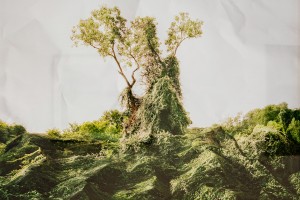What do trees say about how we live our lives and connect to nature? A Gund Gallery exhibition looks at how humans relate to trees and use them for artistic inspiration. “The Art of Trees,” which student associates at the gallery helped to curate, explores themes of restoration and destruction, community and isolation, location and identity.
Curator of Academic Programs Jodi Kovach has helped Kenyon faculty make connections between “The Art of Trees” and their course curricula, in fields ranging from anthropology and American studies to political science and philosophy. Here are just a few examples of how classroom and gallery are colliding at Kenyon:
BIOL 106: Conservation Biology
Associate Professor of Biology Chris Bickford
Students analyze works of art in the exhibition to identify any threats to a particular tree species or to biodiversity more broadly. They explain how the artist has chosen to portray this particular scene and how this offers a unique perspective on an environmental problem. Throughout this exercise, they consider the questions that the artwork raises, and think about how art can help us see a problem with fresh eyes to advance scientific thinking.
ENGL 291.01: Millennial Angst
Visiting Assistant Professor of English Keyana Parks
Students focus on works in the exhibition that open up a discussion about narrative strategies and literary devices used by Jesmyn Ward to evince the realities of environmental and racial injustice in her novel “Salvage the Bones.” For example: What do these works of art tell us about the interrelated exploitation of the natural environment and of the people who live there? What questions might these images raise about the justification for this exploitation? Who has the power to exploit the land’s resources and its inhabitants, and on what grounds? What do the trees in the artwork suggest about who is most vulnerable to the violence of contemporary urbanization and extractive economies?
GERM 325: Approaches to German Literature and Culture
Associate Professor of German Leo Riegert
Students look at the painting “Baltic Woods” by Oliver Dorfer as a representation of a cosmology, described through a form of visual storytelling. They relate this to the symbolic language and subject matter of stories about sacred trees that figured into pre-Christian cosmologies of Germanic and Nordic peoples. Equipped with this insight, students think about how the destruction of sacred trees by Charlemagne and St. Boniface not only served to forbid pagan rituals, but eventually destroyed early Germanic forms of spirituality and imposed different ways of understanding, and expressing, our relationship with nature.
PHIL 250: Existential Themes in Film, Art and Literature
Associate Professor of Philosophy Juan De Pascuale
The week prior to the gallery session, students viewed the documentary/art film “Koyaanisqatsi,” which, in part, explores how we have become cut off from nature. Looking at key pieces in the exhibition, the class discusses how art can conjure the experience of the sublime, speaks about the strategies the artists and the filmmaker use to bring about this aesthetic response, and considers the questions the artwork raises for us about our paradoxical relationship with the natural world. Students establish a dialogue between the artwork on view and the film, in terms of how they help us become critically aware of our alienation from our natural environment.
“The Art of Trees” runs through April 11 at the Gund Gallery.
